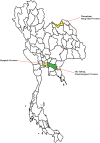Seroprevalence study in humans and molecular detection in Rhipicephalus sanguineus ticks of severe fever with thrombocytopenia syndrome virus in Thailand
- PMID: 38862576
- PMCID: PMC11167008
- DOI: 10.1038/s41598-024-64242-x
Seroprevalence study in humans and molecular detection in Rhipicephalus sanguineus ticks of severe fever with thrombocytopenia syndrome virus in Thailand
Erratum in
-
Author Correction: Seroprevalence study in humans and molecular detection in Rhipicephalus sanguineus ticks of severe fever with thrombocytopenia syndrome virus in Thailand.Sci Rep. 2025 Feb 13;15(1):5406. doi: 10.1038/s41598-025-89292-7. Sci Rep. 2025. PMID: 39948185 Free PMC article. No abstract available.
Abstract
Severe fever with thrombocytopenia syndrome virus (SFTSV) is an emerging tick-borne virus with a mortality rate of up to 30%. First identified in China in 2009, it was later reported in other Asian countries, including Thailand in 2020. SFTSV has been detected in several tick species, including Rhipicephalus sanguineus, known for infesting dogs. We conducted a seroprevalence study of SFTSV in Bangkok and Nong Khai, Thailand, by analyzing 1162 human samples collected between 2019 and 2023. The testing method relied on IgG detection using ELISA and confirmed though a virus seroneutralization test. The results indicated that out of the participants, 12 (1.1%) tested positive for anti-SFTSV IgG antibodies; however, none exhibited positive results in the seroneutralization assay. Additionally, molecular detection of SFTSV, Crimean-Congo hemorrhagic fever (CCHF), Coxiella spp., Bartonella spp., and Rickettsia spp. was performed on 433 Rh. sanguineus ticks collected from 49 dogs in 2023 in Chachoengsao Province, Thailand. No evidence of these pathogens was found in ticks. These findings highlight the importance of exploring viral cross-reactivity. Furthermore, it is important to conduct additional studies to isolate SFTSV from animals and ticks in order to identify the potential transmission routes contributing to human and animal infections in Thailand.
Keywords: Rhipicephalus sanguineus; SFTSV; Seroprevalence; Thailand; Tick-borne diseases.
© 2024. The Author(s).
Conflict of interest statement
The authors declare no competing interests.
Figures
Similar articles
-
High Seroprevalence of Severe Fever with Thrombocytopenia Syndrome Virus Infection among the Dog Population in Thailand.Viruses. 2023 Dec 11;15(12):2403. doi: 10.3390/v15122403. Viruses. 2023. PMID: 38140644 Free PMC article.
-
Seroprevalence and transmission of severe fever with thrombocytopenia syndrome virus in a coastal endemic area in Southeastern China.Ticks Tick Borne Dis. 2024 Jan;15(1):102277. doi: 10.1016/j.ttbdis.2023.102277. Epub 2023 Nov 17. Ticks Tick Borne Dis. 2024. PMID: 37981467
-
Novel phlebovirus-like-AYUT and Stenotrophomonas maltophilia bacterial co-infection in a Rhipicephalus sanguineus s.l. tick.Vet Res Commun. 2022 Feb;46(1):277-282. doi: 10.1007/s11259-021-09855-7. Epub 2021 Nov 2. Vet Res Commun. 2022. PMID: 34725749 Free PMC article.
-
Animals as amplification hosts in the spread of severe fever with thrombocytopenia syndrome virus: A systematic review and meta-analysis.Int J Infect Dis. 2019 Feb;79:77-84. doi: 10.1016/j.ijid.2018.11.017. Epub 2018 Nov 27. Int J Infect Dis. 2019. PMID: 30500443
-
Comprehensive meta-analysis of severe fever with thrombocytopenia syndrome virus infections in humans, vertebrate hosts and questing ticks.Parasit Vectors. 2024 Jun 20;17(1):265. doi: 10.1186/s13071-024-06341-2. Parasit Vectors. 2024. PMID: 38902842 Free PMC article.
Cited by
-
Safety, Immunogenicity, and Efficacy of a Recombinant Vesicular Stomatitis Virus Vectored Vaccine Against Severe Fever with Thrombocytopenia Syndrome Virus and Heartland Bandavirus.Vaccines (Basel). 2024 Dec 12;12(12):1403. doi: 10.3390/vaccines12121403. Vaccines (Basel). 2024. PMID: 39772063 Free PMC article.
-
Mutations in the voltage-gated sodium channel associated with permethrin resistance in Rhipicephalus linnaei populations in Thailand.Sci Rep. 2025 Mar 2;15(1):7369. doi: 10.1038/s41598-025-91600-0. Sci Rep. 2025. PMID: 40025163 Free PMC article.
References
MeSH terms
Substances
Grants and funding
LinkOut - more resources
Full Text Sources
Miscellaneous


